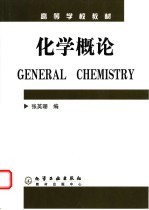图书介绍
化学概论pdf电子书版本下载

- 张英珊编 著
- 出版社: 北京:化学工业出版社
- ISBN:7502555919
- 出版时间:2005
- 标注页数:339页
- 文件大小:31MB
- 文件页数:352页
- 主题词:普通化学-高等学校-教材
PDF下载
下载说明
化学概论PDF格式电子书版下载
下载的文件为RAR压缩包。需要使用解压软件进行解压得到PDF格式图书。建议使用BT下载工具Free Download Manager进行下载,简称FDM(免费,没有广告,支持多平台)。本站资源全部打包为BT种子。所以需要使用专业的BT下载软件进行下载。如 BitComet qBittorrent uTorrent等BT下载工具。迅雷目前由于本站不是热门资源。不推荐使用!后期资源热门了。安装了迅雷也可以迅雷进行下载!
(文件页数 要大于 标注页数,上中下等多册电子书除外)
注意:本站所有压缩包均有解压码: 点击下载压缩包解压工具
图书目录
CONTENTS 1
Chapter 1 Gases,Gas Phase Equilibria 1
1.1 The Perfect-gas Law 1
1.2 The Partial Pressures of Components of a Gas Mixture 5
1.3 The Kinetic Molecular Theory of Gases 8
1.4 Diffusion and Effusion 10
1.5 Real Gases 12
1.6 The Scientific Method 14
1.7 Chemical Equilibrium in gaseous state 15
1.8 Le Ch?telier's Principle 20
1.9 Heterogeneous Equilibria 23
Chapter 2 Chemical Thermodynamics 27
2.1 First Law of Thermodynamics 27
2.2 The Isothermal Expansion of an Ideal Gas 30
2.3 Enthalpy and Enthalpy Change 32
2.4 Second Law of Thermodynamics 38
2.5 Gibbs Free Energy and Spontaneity 44
2.6 Interpretation of Free Energy 46
Chapter 3 Chemical Kinetics 53
3.1 Reaction Rates 53
3.2 Rate Laws and Reaction Order 56
3.3 Determining the Rate Law 58
3.4 Temperature and Rate:A Model for Chemical Kinetics 62
3.5 Reaction Mechanisms 66
3.6 Catalysis 68
Chapter 4 Atomic Structure and the Periodic Table of the Elements 72
4.1 Dalton's Atomic Theory 72
4.2 Basic Compositions of Atoms 73
4.3 The Birth of the Quantum Theory 73
4.4 The Atomic Spectrum of Hydrogen and Bohr Theory 75
4.5 The Quantum Mechanical Description of Hydrogen Atom 78
4.6 Polyelectronic Atoms 82
4.7 Electron Configurations of Atoms 84
4.8 Electron Diagrams of Atoms 87
4.9 The Periodic Table 88
4.10 Periodic Trends in Atomic Properties 90
Chapter 5 The Chemical Bond 97
5.1 Types of Chemical Bonds 97
5.2 Ionic Bond 97
5.3 Covalent Bond 102
5.4 Describing the Valence Electron Arrangement 104
5.5 Predicting the Molecular Structure:The VSEPR Model 109
5.6 Valence Bond Theory:Hybrid Orbitals 113
5.7 Polar covalent Bond 119
5.8 Bond Energy 121
5.9 Molecular Orbital Theory 123
5.10 Orbitals:Human Inventions 128
Chapter 6 Liquid and Solid 132
6.1 Intermolecular Forces 132
6.2 The Properties of Liquid State 135
6.3 Solid state 136
6.4 Lattices 139
6.5 Metallic Crystals 141
6.6 Ionic Crystals 143
6.7 Covalent Network Solids:Carbon and Silicon 145
6.8 Phase Transitions 146
Chapter 7 Acid-Base Equilibria 153
7.1 Acid-Base concept 153
7.2 Water as an Acid and a Base 155
7.3 Relative Strengths of Acids and Bases 156
7.5 Calculating the pH of Weak Acid Solutions 158
7.4 The pH Scale 158
7.6 Acid-Base Properties of Salts 161
7.7 Acid Solutions in Which Water Contributes to the H+Concentration 165
7.8 Common Ion Effect 167
7.9 Buffered Solutions 169
7.10 Acid-Base Titration 171
Chapter 8 Solutions 183
8.1 Solubility 183
8.2 Solubility Equilibria 187
8.3 Complications Inherent in Solubility Calculations 195
8.4 Complex Ion Equilibria 195
8.5 Colligative Properties 199
8.6 Colloidal Solution 205
9.1 Electrochemical Cells 209
Chapter 9 Electrochemistry 209
9.2 Standard Reduction Potentials 213
9.3 Electrochemistry and Thermodynamics 217
9.4 Dependence of the Cell Potential on Concentration 218
9.5 Batteries 221
9.6 Corrosion 223
9.7 Electrolysis 224
9.8 Commercial Electrolytic Processes 226
Chapter 10 The Main-Group Elements 230
10.1 A Survey of the Main-Group Elements 230
10.2 Group ⅠA Elements 234
10.3 The Chemistry of Hydrogen 236
10.4 The Group ⅡA Elements 238
10.5 The Group ⅢA Elements 240
10.6 The Group ⅣA Elements 242
10.7 The Group ⅤA Elements 246
10.8 The Chemistry of Nitrogen 248
10.9 The Chemistry of Phosphorus 252
10.10 The Group Ⅵ A Elements 254
10.11 The Chemistry of Sulfur 256
10.12 The Group ⅦA Elements 259
10.13 The Group ⅧA Elements 263
Chapter 11 Transition Metals and Coordination Chemistry 268
11.1 Properties of the Transition Elements 268
11.2 The chemistry of First-Row Transition Metals 272
11.3 Complex Ions and Coordination Compounds 279
11.4 Structure and Isomerism 283
11.5 Valence Bond Theory of Complex Ions:The Localized Electron Model 284
11.6 The Crystal Field Model 287
11.7 The Biological Importance of Coordination Complexes 291
Appendix A Mathematical Procedures 295
A1 Uncertainties in Measurements 295
A2 Significant Figures 299
A3 Discordant Data 300
Appendix B Spectral Analysis 302
Appendix C Naming Simple Compounds 306
C1 Binary Ionic Compounds 306
C2 Ionic Compounds with Polyatomic Ions 307
C3 Covalent Compounds 307
C4 Hydrates 308
Appendix D Selected Thermodynamic Data 309
Appendix E Equilibrium Constants and Standard Reduction Potentials 312
Appendix F 314
GLOSSARY 318
Reference Materials 339